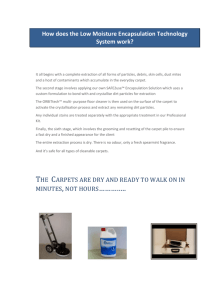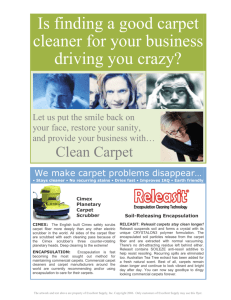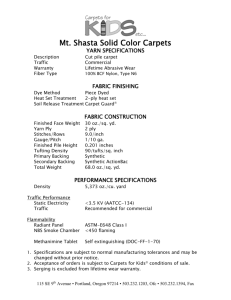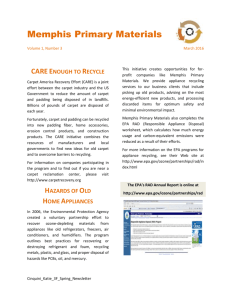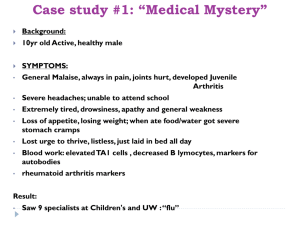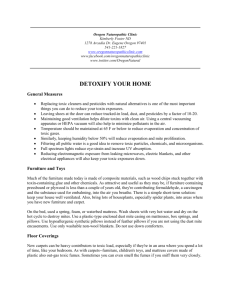Risk Assessment for Methyl Isocyanate Inhalation
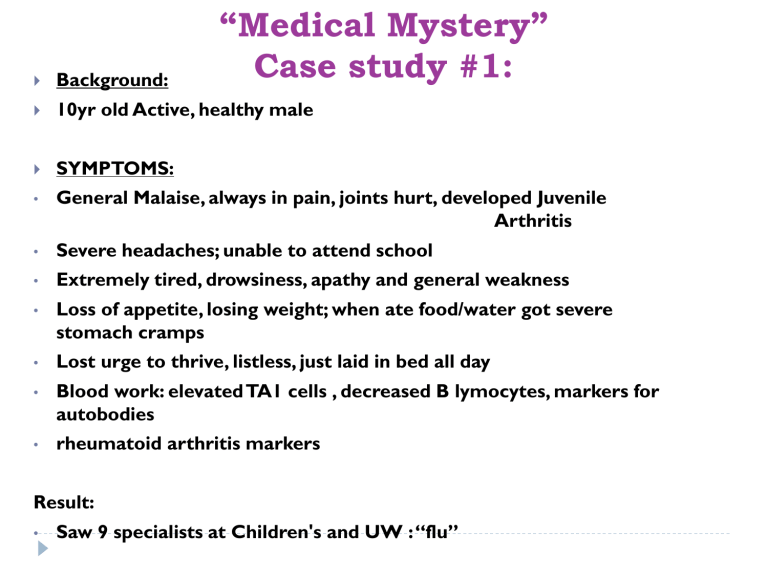
Background:
“Medical Mystery”
Case study #1:
10yr old Active, healthy male
•
•
•
•
•
•
•
SYMPTOMS:
General Malaise, always in pain, joints hurt, developed Juvenile
Arthritis
Severe headaches; unable to attend school
Extremely tired, drowsiness, apathy and general weakness
Loss of appetite, losing weight; when ate food/water got severe stomach cramps
Lost urge to thrive, listless, just laid in bed all day
Blood work: elevated TA1 cells , decreased B lymocytes, markers for autobodies rheumatoid arthritis markers
•
Result:
Saw 9 specialists at Children's and UW : “flu”
Risk Assessment for the
Exposure to Isocyanates (in carpets)
Isocyanate Monitoring System
What are Isocyanates?
Where they’re found:
The Compound
Isocyanate molecules have the functional group -N=C=O.
Carpets (newly installed)
Upholstery
Foam
Mattresses
Paints/Auto finish
Surface coatings (laminates)
Adhesives
Dream HOME ?
“I wanted the house to be so nice, and then I poisoned my son with it.”
Partial list of Some of the Over 200
Chemicals Found in Manufactured Carpet
(provided by a carpet manufacturer)
ethylbenzene formaldehyde methacrylate acid methyl methacrylate acrylic oligomers tetrachloroethylene toluene xylenes
4-phenylcyclohexene acetonitrile azulene benzene biphenyl
2-butyloctanol-1 cyclopentadiene-ethenyl-
2-ethylene
1,3,5-cycloheptatriene
1-chloronaphthalene diphenyl ether dodecane
1,4dihydroxyacenophthene ethylxylene
1-ethyl-3-methylbenzene hexadecanol hexamethylene triamine
1-h-indene
1-methylnaphthalene
2-methylnaphthalene
1-methyl-3 propylbenzene
2-methyl-4-tridecene
5-methyltridecane octadecenyl amine (oleylamine) oxarium polyacrylates
1-phenylcyclopentanol
2-propylheptanol phthalic esters styrene
1,2,3,-trimethylbenzene
1,2,4,-trimethylbenzene tetradecene
2,3,7-trimethyldecane undecane,2,6-dimethyl
*By selecting Green Label Plus carpet or adhesive, you are assured one of the lowest emitting products on the market, and you may be able to earn LEED or
Green Guide for Health Care points.
!! HAZARDS!!
Symptoms associated with exposure to the chemicals
(provided by industrial hygienists)
•
•
•
•
•
•
•
•
•
•
•
•
•
• eye irritation throat cancer blurred vision eyes sensitive to light throat irritation loss of voice cough dry or thirsty mouth lips burning tongue burning nose burning or bleeding loss or increase of smell moodiness respiratory tract irritation
• rash or itching
• hair loss
• weight loss or gain
• flu-like symptoms
• aggravated asthma
• aggravated allergies
• joint pain
• muscular aches
• abdominal pain
• memory loss
• poor concentration
• nervous system disorders
• unusual depression
• Irritability
• headaches
• dizziness,
• disorientation
• vomiting
• nausea
• chest pains
• shortness of breath
• irregular heart beat
• high blood pressure
• drowsiness
• unusual fatigue
• chemical sensitivity
• jerking in sleep
• menstrual irregularities
• sexual dysfunction
Chemical
Benzene, formaldehyde, ethyl benzene, styrene, acetone
Health Effects
CANCER
4-PC (used in the latex backing of
95% of US carpets)
Scotchgard (perflouro-octanyl salphonate)
Eye, nose and upper respiratory problems
Reproductive problems in rats
Naphthalene (mothproofing chemicals) Produce toxic reactions, especially in newborns
PBDE’s (fire retardants) Damage to thyroid, immune system and brain development functions in humans
Bhopal, India
Catastrophic Chemical Leak and Explosion
Bhopal, India Gas Leak Disaster 1984
Cauldron of Chemical Soup
Toxic “ Cocktail ”
BENZENE
C-8 acetonitrile
PFC’ s
Isocyanates
PFOA
P.B.D.E.
Micron(pesticide)
Case study #2:
Mr. Braithwaite:
-Started laying carpets at 10 with father
-Disabled at 39 yrs. old
-Father died of lung cancer at 58
Symptoms:
-severe concentration problems
-memory loss
-ringing in his ears
-erratic heartbeats
-shortness of breath
-recurring nosebleeds
-coordination problems
-gastrointestinal problems
-numbness in lower arms/hands.
Neurological testing:
-SPECT scan verified damage to his brain
- Doctors convinced solvents/other chemicals in carpets/glues he worked with are cause
Case Study #2: (cont.)
• Dad died of lung cancer when he was 58
• Another carpet layer, a good friend died same way
• Many carpet layers in our area died of cancer
• Developed other serious health problems when they were relatively young
"I want to know the names of all the chemicals I have been working with for the past twenty plus years. I should have a legal right to know what has been poisoning me," he says. "I want to know why I was never given any warnings about any of this all the years I laid carpet.
•how many other families?
• how many little children made seriously ill?
•before the CRI honestly admits to the problem and stops putting out products that place people at risk?“
Case Study #3:
Exposure: foam mattress
• Worked at a foam mattress factory, the chemicals used are quite nasty
• Main chemical to worry about: TDI, which I believe is from the isocyanate family
• Remnants of this chemical remain in the mattress
• Have regular drills in case of a spill or a leakage. The gas given off by this chemical was odorless and lethal
• Carry a gas mask
• Sirens during leakage
• 100 yards long ventilation warehouse, emergency exits every 10 yards to escape!!
http://cr4.globalspec.com/thread/3496/Memory-Foam-or-Foamy-Memory
Case Study #4
10 month boy, Christopher, on the carpet.
• Went into strange seizure-like reaction
• Upper body tensed up, arms started shaking, and his jaw moved awkwardly
• Doctors ruled out multiple sclerosis, muscular dystrophy, and tumors
• "tremors of unknown origin"
• Doctors tried drugs but didn't stop the tremors.
•
Parents had carpet tested in a lab: “the mice were rolling over and shaking just like Christopher
•
Ripped out the carpet, the tremors stopped.
Testing on Christopher showed:
• Immune system damage consistent with chemicals exposure,
• Autoimmune disease, myelin in his nervous system -- a sign of nerve tissue damage
Risk Assessment
Chronic Human Respiratory and
Immune Exposure to Isocyanates
Isocyanates Inhalation Exposure
Human
Immune
NOAEL.
.0006ppm
=
.oo14mg
Human
Resp.
NOAEL
.0002ppm
=.0061 mg/m 3
Conversions for human Inhalation
Exposure
1 ppm = 2.34 mg/m 3
1 mg/m
3
= .4274 ppm
Example:
LOAEL for respiratory system is .0006ppm
.0006ppm x 1mg/m
3
/.4274 ppm =.0014mg/m
3
Assessment/Exposures
: using BioMarkers notes from Dr.Costa’s lecture Feb 10, 2010
Adverse Affects:
• Nervous system, O
2 and glucose requirements
• Memory loss
• Cognitive Impairment
Humans now have this “ neurotox index”. Neurotoxins affect cell to cell interaction biomarkers: Polymorphisms
On cell surface have structures made out of glycoprotein, that after toxic exposures: have missing parts . If our body can not replace those missing parts (called glyconutrients) then it destroys those structures. This is what causes “ auto-immune ”
(where body attacks itself). It’s a response that a lot of people have and most carpet layers have.
• sugars that a stressed body can’t make, then have to come from our food, which can be depleted of these sugars. (Castor).
• Mannose is one of those key sugars, our body uses to repair and restore the cellcell communication. Stop body self-destruction, or auto immune response } .
• 5 of the 8 necessary sugars are present in human breast milk .
* Manifests: chronic fatigue, lupus, fibromyalgia, brain fog, severe headaches,
Multiple chemical sensitivities (MCS), hearing loss, memory loss (see symptom list)
Study of Glycobiology
One solution of toxic exposures
"Carbohydrates are the glue that pulls things together, the cell surface matrix in which cells communicate, and they provide the connections for signal transduction. It's only been within the last decade that we've realized that such structures are critical for all kinds of biological function."
ScienceDaily.com- May 15, 2008
In 1996 Harper's Biochemistry, a medical text, introduced "the eight principal sugars found in human
glycoproteins." Eight specific sugars were identified on human cell surface glycoforms which are involved in cellular recognition processes.
Precautionary Risk Assessment
Hazard, Community, Exposure Issues
Parameter
Community/Social Issues
Score
G = Goal
N = Need
3 – does NOT move forward the goal of human and environmental health
3 – we do NOT need this
F = Future generations
D = Democratic community based process
A = Alternatives
Total
3 – there is VERY HIGH potential impact on future generations
3 – hardly anyone knows about the risks and hazards
3 – some companies switched out formaldehyde for isocyanates...
15/15
– NOT SUPPORTIVE OF
HEALTH OR COMMUNITY
Parameters
E = Exposure
M = Multiple exposure
Ch = Children exposed
CP = Consumer products
Exposure Issues
Score
O = Occupational exposure
1 – we have LITTLE control over exposure from carpets
3 – very WIDE range of chemicals in carpets
5 – children, especially infants are at the greatest risk, in their breathing zone
3 – carpets are in almost every home/work place, and many other products
3 – insocyanates are everywhere
F = Food exposure
Total
0 – not found in food
15/20 – serious concern
Parameters
Hazard/Toxicity Issues
Score
Hazard 10 – very toxic, very hazardous
Individual sensitivity
Ecological hazard
Volume
3 – young children, infants sick within a couple hours
3 – same health effects seen in mammalian studies
5 – extreme concentrations
Persistent
Bioaccumulation
Uncertainty
Total
3 – stays around
2 – some, most neurotoxins
2 – not very much official research, but many real-life case studies
28/30 – LIKE SO
HAZARDOUS!!
COVER UP by the CRI
(Carpet Rug Institute)
" The carpet industry has mounted a massively deceptive merchandising campaign that intentionally mislead the public by implying that all carpets with the green tag
have met safety standards," says New York Attorney General Robert Abrams . He had petitioned CPSC( Consumer Product Safety Commission ) to require warning labels on carpets.
Because of the large number of carpet complaints, the attorneys general of twenty-five other states signed the petition as well. (9) CPSC refused to even consider their petition.
• there are no such recognized standards of safety. The Carpet and Rug Institute its own arbitrary standards.
• CRI's testing program is completely inadequate because it measures only a small percentage of the chemicals emitted from carpets.
• a manufacturer can get a green tag for an entire product line simply by having one small piece of carpet tested once a year."
• One of the carpets to pass the green tag testing is associated with disabling the members of the Charles
Fitzgerald family of West Friendship, Maryland,who were exposed to it in their lighting store in 1992. When tested by Anderson Labs, the Fitgeralds' carpet caused gross nervous system abnormalities in mice."
• The Consumer Product Safety Commission receives hundreds of complaints and inquiries each year about the adverse health effects associated with the materials used to make carpet,"said Abrahms.
Yet the government has chosen to sweep this problem under the rug by ignoring the public's health concerns as well as my request to disseminate meaningful information about potential carpet hazards."
•“ Nothing has been proven to date that links carpet and ill health effects," says the
CRI's Kathryn Wise .
Cover up (con’t)
EPA cover-up
• a thousand complaints were reported by EPA workers who were made ill by new carpet in the EPA headquarters building. The CRI were
, at a minimum, well aware of neurological complaints and very serious pulmonary complaints from a number of EPA workers."
•
Despite its own study, and the removal of 27,000 square yards of carpet from the headquarters building in 1989, EPA published a public information brochure, "Indoor Air Quality and New Carpet: What
You Should Know," which states, "Limited research to date has found no links between adverse health effects and the levels of chemicals emitted by new carpet
." http://www.holisticmed.com/carpet/
•
When EPA returned to its own labs, "instead of duplicating what Rosalind Anderson did, as they were charged to do at the October '92 carpet hearing, EPA created its own protocol," bottled air in their own lab and bubbled it through water to add humidity, the humidity changed the result. What they found was that humidity reduced the toxicity, so apparently whatever the toxins are, they are soluble in water at low levels." After Anderson Labs changed their protocol to humidify the air in the same manner as EPA had done," we found it removed the toxic effect as well," said Anderson. When they passed air over a toxic carpet sample and bubbled it through water, the air was not toxic to the mice.
• took that water and exposed the mice to it in the form of a mist. "Lo and behold, the toxic effect had been removed from the air and put into the water.
• We were now seeing the same enurotoxic effects from the water, including death, said Anderson.
Recommendation:
• Do not contact the EPA or Consumer Product Safety Commission (CPSC) with the expectation of getting help with the problem. While they may do good work on other issues, they are in bed with the industry on this issue, so do not trust anything they say. http://www.holisticmed.com/carpet/
Cover up (con’t)
Peer –reviewed articles and journals are mistakenly presented to be of high quality.
Product defense firms establish their own journals, using their own scientists, that present themselves to the unwary as independent sources of information and science.
Example: Indoor and Built Environment Journal
Resources:
• To understand how PR techniques are sometimes used to by Monsanto, Dupont and others to con the general public, please purchase and read the excellent new book: Toxic Sludge is Good For You! (Lies,
Damn Lies and the Public Relations Industry by John Stauber and Sheldon Rampton Common Courage
Press, Monroe, Maine (USA), c1995 ISBN 1-56751-061-2 or ISBN 1-56751-060-4 (pbk.) This book will help you understand what tricks to expect from Monsanto, Dupont, and others as scientists and the general population recognizes the dangers from exposure to toxic carpeting.
• Doubt is Their Product David Michaels, 2008 by Oxford Press
Peer –reviewed articles and journals are mistakenly presented to be of high quality.Product defense firms establish their own journals, using their own scientists, that present themselves to the unwary as independent sources of information and science.
Examples: JOURNAL: Indoor and Built Environment , financed by the tobacco industry to promote that inadequate ventilation, not second hand smoke, is the problem.
JOURNAL : Regulations, Toxicology and Pharmacology An association dominated by scientist who work for industry trade groups and consulting firms.
•
In 1986 Duehring founded the
Environmental Access
Research Network (EARN).
• 1991, the Agency for Toxic
Substances and Disease
Registry designated CIIN a clearinghouse to aid communities and individuals on the toxic health effects associated with low levels of chemical exposure
• In 1994 became Chemical
Injury Information Network
(CIIN).
CIIN is a support and advocacy organization for the benefit of the chemically injured with over
5,000 members in 35 countries.
Its primary focus is education, credible research, multiple chemical sensitivity (MCS), and the empowerment of the chemically injured.
She was awarded
The Right Livelihood
Award
“...
for putting her personal tragedy at the service of humanity by helping others understand
CIIN works with healthcare professionals and governments in many countries, and the United
Nations Environment
Program and the
European Union have both recognized
.
CIIN/EARN's work.
Cindy Duehring
(1962 - 1999)
Researcher, Activist, Writer, Editor
1997 Right Livelihood Award Winner
and combat the risks posed by toxic chemicals.”
Sources
www.ciin.org The Chemical Center Information Network http://www.inspiredliving.com/airpurification/a~toxic-carpets1.htm
http://www.naturalhomeproducts.com/1430chemicals.html
Natural
Home Design Center
Journal of nutritional medicine ISSN 0955-6664 Source / Source
1995, vol. 5, n o 4, pp. 375-386 (24 ref.
) http://webmail.aol.com/30746-
111/aol-1/en-us/Suite.aspx
CARPET CONCERNS: Carpet Installers Speak Out
As the Medical Evidence Mounts.by Cindy Duehring http://www.inspiredliving.com/airpurification/a~toxic-carpets2.htm
Methyl Isocyanate. Technology Transfer Network., EPA. November 6,
2007. January 32, 2010. http://www.epa.gov/ttn/atw/hlthef/methylis.html
Lecture: Sam Castor, On History of Glycoproteins, a New Biology. Feb
19, 2010. Seattle , WA
Lecture: Dr. Costa, UW , Seattle, WA Feb 17, 2010 http://www.glycoscience.co.za/index.htm
http://www.rightlivelihood.org/uploads/tx_templavoila/Kopbilder_Recipients_01.jpg
http://www.holisticmed.com/carpet/ summary of cover-up,examples of disable carpet layers
